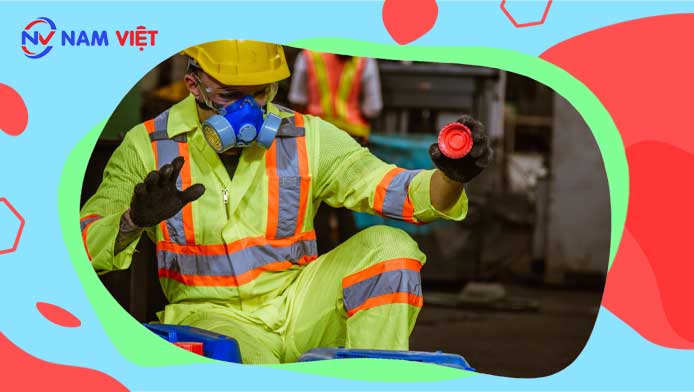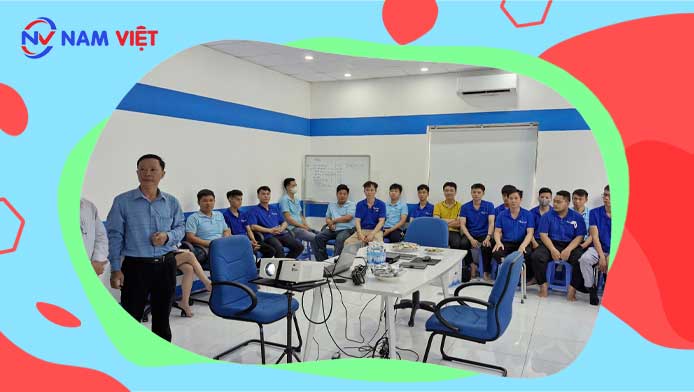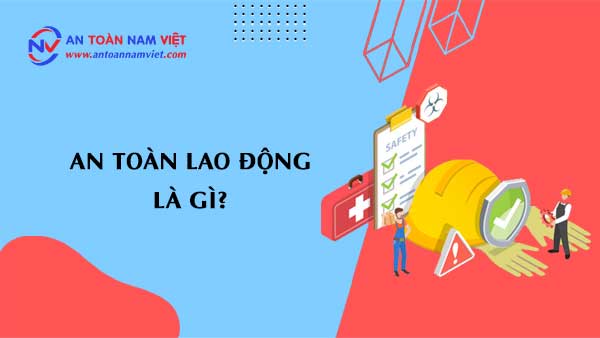Safety management
What is Occupational Safety?
Occupational Safety plays a crucial role in protecting the health and safety of workers in the workplace. To provide a deep and detailed insight into this topic, expert Lê Thế Quý will guide you through the regulations, importance, and practical solutions to ensure a safe and effective working environment. In this article, you will find the necessary information to better understand Occupational Safety and how to apply it in practice.
I. What is Occupational Safety?
Occupational safety is a set of measures, regulations, and procedures aimed at protecting the health and lives of workers during their work. It includes the assessment, control, and minimization of hazards and risks that can cause accidents, injuries, or health problems in the work environment. Occupational safety applies not only to heavy industries such as construction and mechanics but also to all other occupations, including offices, services, and agriculture.
According to Vietnam’s Law on Occupational Safety and Health 2015, both businesses and employees are responsible for implementing safety measures to ensure a safe working environment. This includes providing personal protective equipment, training on safety procedures, and monitoring compliance with relevant legal regulations.
The goal of occupational safety is to minimize or completely eliminate harmful risks, creating a working environment that is not only safe but also comfortable, helping to improve the productivity and morale of workers. Strict adherence to occupational safety regulations also helps businesses avoid financial and legal losses that can result from workplace accidents.

II. The Importance of Occupational Safety
Occupational safety plays an extremely important role in protecting the health and lives of workers, as well as ensuring the effective and sustainable operation of a business. A safe working environment not only helps prevent accidents and injuries but also creates conditions for employees to work with peace of mind, thereby increasing productivity and work quality. This is particularly important in risk management and ensuring the sustainable development of the business.
Implementing effective occupational safety measures helps minimize the risk of workplace accidents, while also contributing to reducing related costs for injury treatment, sick leave, and production interruptions. For businesses, complying with occupational safety regulations is not only a legal obligation but also helps protect their reputation and brand image. Businesses that violate occupational safety regulations may face severe penalties, affecting their profits and long-term growth.
Furthermore, occupational safety promotes a positive work culture within the company, as employees feel protected and valued. This not only helps improve work morale but also reduces turnover rates, improves employee loyalty, and strengthens internal cohesion. In the context of global competition, occupational safety is not only a crucial factor for retaining employees but also a competitive advantage for the business.
III. Legal Regulations on Occupational Safety
Legal regulations on occupational safety in Vietnam are established to protect the rights and ensure the safety of workers during their work. These regulations include laws, decrees, and guiding circulars, with the Law on Occupational Safety and Health 2015 being the primary legal basis. This law requires all businesses, production facilities, and organizations to implement risk prevention measures, ensuring a safe and healthy working environment for employees.
According to the law, businesses must conduct risk assessments, provide safety training for employees, supply personal protective equipment, and carry out regular monitoring to ensure safety during work processes. Additionally, the law clearly stipulates the organization of periodic training courses for managers and employees to enhance awareness and skills in occupational safety. Businesses that fail to comply with these regulations may be penalized with financial fines or other administrative sanctions.
Moreover, legal regulations also require businesses to report workplace accidents, investigate their causes, and take timely corrective actions to prevent recurrence. Strict compliance with occupational safety regulations not only helps protect workers but also helps businesses avoid financial losses and damage to their reputation due to legal violations.

IV. Practical Solutions to Enhance Occupational Safety
Enhancing occupational safety requires practical, feasible solutions that can be applied flexibly across various industries. One of the most important solutions is to build a safety culture in the workplace, helping every employee become clearly aware of the importance of adhering to safety rules. This can be achieved through regular training sessions, organizing occupational safety quizzes, and encouraging everyone to proactively report potential hazards.
Besides, providing adequate personal protective equipment (PPE) is a mandatory factor. Ensure that all employees are supplied with equipment suitable for their specific job and work environment, such as safety helmets, goggles, gloves, or respirators. Businesses need to regularly inspect and maintain this equipment to ensure it is always in good working condition.
Finally, the application of technology is also an effective solution for enhancing occupational safety. Automated monitoring systems, such as surveillance cameras, temperature and vibration sensors, can provide early warnings of potential hazards, thereby minimizing the risk of workplace accidents. In addition, safety management software helps to track, report, and analyze accident data, leading to continuous improvement measures to enhance the effectiveness of occupational safety solutions.
V. Measuring the Effectiveness of Safety Measures
Measuring the effectiveness of occupational safety measures is a crucial step that helps businesses assess their success in protecting the health and safety of their employees. The most common method is to track indicators of workplace accidents, including the number of accidents, their severity, and their frequency. Analyzing this data will help identify high-risk areas or processes to implement effective preventive measures.
Additionally, surveying employee opinions about the work environment and compliance with safety regulations is another way to assess the effectiveness of safety measures. Feedback from employees directly involved in production will provide valuable information about unidentified risks and ways to improve safety. Conducting internal audits or hiring an independent consulting firm for inspections also helps ensure objectivity and comprehensiveness in the assessment.
Finally, the use of technological tools such as safety management software helps to collect, store, and analyze data on accidents and safety risks accurately. From there, businesses can track improvement progress and measure the effectiveness of safety measures over time, ensuring the work environment becomes progressively safer for employees.
VI. Reputable National Occupational Safety Center
At An Toan Nam Viet, we always prioritize our professional dedication to occupational safety training. For us, imparting the knowledge of self-protection to workers so they have the safety tools for their livelihoods is a contribution to building the nation.
Our occupational safety training instructors are experts with many years of experience in the field. They even have research projects identifying hazards in all industries and how to prevent them.
The instructors’ lectures are drawn from practical experience and delivered in a vivid, easy-to-understand manner to the workers. These factors help workers feel comfortable during their study time and absorb our teaching knowledge well. Of course, the knowledge conveyed always adheres to Decree 44/2016/ND-CP.
From there, they learn many measures to prevent hazards and how to protect themselves. They can also apply it most appropriately in their actual work.
Our safety training center is proud to be a reputable and professional provider of occupational safety training services with the following advantages:
- Competitive training costs while ensuring the quality of training is maintained.
- Flexible training schedules to accommodate the production situation of companies and businesses.
- Quick and legally compliant procedures for issuing occupational safety training certificates.
- Training instructors are individuals with many years of experience in the profession.
- Classrooms are controlled for factors affecting the training process, increasing teaching efficiency and the students’ ability to absorb knowledge.
- Lectures are tailored to be relevant to occupational safety practices at businesses.
- An Toan Nam Viet works with dedication and professionalism to support customers accurately and quickly.
Nam Viet’s occupational environment monitoring center is a professional unit for monitoring and measuring the quality of the working environment across all provinces in Vietnam. With a team of experienced monitoring specialists, the center uses modern measuring equipment to ensure accuracy and reliability.
VI. Frequently Asked Questions
1. What measures can businesses take to minimize workplace accidents?
- Regular risk assessment: Identify hazardous factors in the work environment and implement specific preventive measures.
- Safety training: Provide periodic training courses for employees on safety rules and skills.
- Provide protective equipment: Supply and maintain adequate personal protective equipment suitable for the job.
- Conduct safety inspections: Periodically inspect and maintain equipment and machinery to ensure safe operation.
- Create a safety culture: Encourage employees to report hazards and incidents for timely resolution.
2. What are the penalties for businesses that do not comply with occupational safety regulations?
- Fines: Businesses may be fined depending on the severity of the violation and the size of the organization.
- Suspension of operations: In cases of serious violations, authorities may suspend the business’s operations for remediation.
- Criminal prosecution: If a violation causes serious consequences to the life or health of workers, individuals involved may face criminal prosecution.
3. How can businesses measure the effectiveness of their occupational safety measures?
- Track accident rates: Evaluate the number and severity of accidents that occur.
- Survey employee opinions: Collect feedback from employees on the effectiveness of safety measures.
- Periodic inspections and audits: Conduct internal inspections and audits or hire external services to determine the effectiveness of the measures.
4. Which occupations have the highest risk of workplace accidents and why?
- Construction: Due to working at heights, exposure to heavy machinery, and unstable working conditions.
- Industrial manufacturing: Due to working with dangerous machinery, equipment, and hazardous chemicals.
- Agriculture: Due to dealing with agricultural machinery, chemicals, and uncontrollable outdoor working conditions.
5. How can workplace accidents be handled without significantly affecting the company’s operations?
- Timely response: Take injured employees to a medical facility immediately and provide necessary medical support.
- Report and investigate: Immediately report the incident and conduct an investigation to determine the cause and prevent recurrence.
- Improve processes: Update and adjust safety measures and work procedures to prevent future accidents.
- Ensure communication: Provide information and training to employees on new safety measures to maintain effective operations.
VII. Conclusion
Occupational safety is not only a legal obligation but also the responsibility of every business and employee. Implementing effective safety measures not only helps protect the health and lives of employees but also enhances productivity, minimizes risks, and safeguards the company’s reputation. To achieve this, there must be a commitment from both management and staff, along with the synchronized application of regulations, technology, and practical methods. A safe and healthy work environment will not only benefit each individual but also contribute to the sustainable development of the business.

